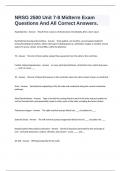NRSG 2500 Unit 7-8 Midterm Exam
Questions And All Correct Answers.
Hyperkalemia - Answer Result from massive cell destruction immediately after a burn injury
Dysrhythmia Nursing Interventions - Answer Treat patient, not monitor, assess/support patient's
airway/breathing/circulation, obtain vital signs including pulse ox, administer oxygen as needed, ensure
patent IV access, obtain 12-lead EKG, notify the physician
70 - Answer Percent of total cardiac output flows passively from the atria to the ventricles.
Cardiac Output/Hypotension - Answer In some atrial dysrhythmias, atrial kick is lost, which decreases
___ and can cause ___
30 - Answer Percent of blood that passes to the ventricles when the atria contact, known as atrial kick.
Sinus - Answer Dysrhythmia originating in the SA node and conducted along the normal conductive
pathways
Atrial Dysrhythmias - Answer Type of arrythmia causing blood to pool in the atria and puts patient at
risk for thrombi that could potentially travel to other parts of the body, including the brain (stroke)
Pulmonary/oxygen - Answer The right ventricle pumps blood into ___ circulation for ___
Systemic/body - Answer The left ventricle pumps oxygenated blood into the ___ circulation for ___
Depolarization/Myocardial Contraction - Answer Electrical impulses generated by the exchange of
ions-- primarily potassium, sodium, chloride, and calcium-- cause ____ and __
60-100 - Answer BPM generated by the SA node
, 30-40 - Answer BPM generated by the SA node
20-40 - Answer BPM generated by the Purkinje fibers
GI Burn Complications - Answer Paralytic ileus, Curling's ulcer, and translocation of bacteria
Emergent Burn Priorities - Answer Airway/breathing/circulation, shock prevention, prevention of
respiratory distress,, treatment of contaminant injuries, wound care
Acute Burn Phases - Answer Wound care, nutritional support, infection prevention, pain management,
and preventing complications
Acute Burn Priorities - Answer Wound care/closure, treating complications/infection, nutritional
support
Burn Procedures - Answer Extinguish or remove heat source, cool the burn, remove restrictive objects ,
cover wound, irrigate chemical burns
Burn Nursing Management - Answer Respiratory and cardiac monitoring, vital signs, Doppler for BP if
necessary,, arterial catheter for severe burn patients, elevate burned extremities, strict I&O,
Burn Nursing Treatment - Answer Administering fluids, I&O, monitoring poatient response, document
body temperature,, weight, pre-burn weight
Upper Airway Burn Nursing Interventions - Answer Provide oxygen, respiratory assessment, observing
erythema/blistering, nasal hairs, hoarseness, ABG's, prepare to assist with intubation and escharotomies
of chest
Smoke Inhalation Nursing Interventions - Answer Maintain airway, provide oxygen, turn/cough/deep
breathe to promote mobilization and removal of secretions




